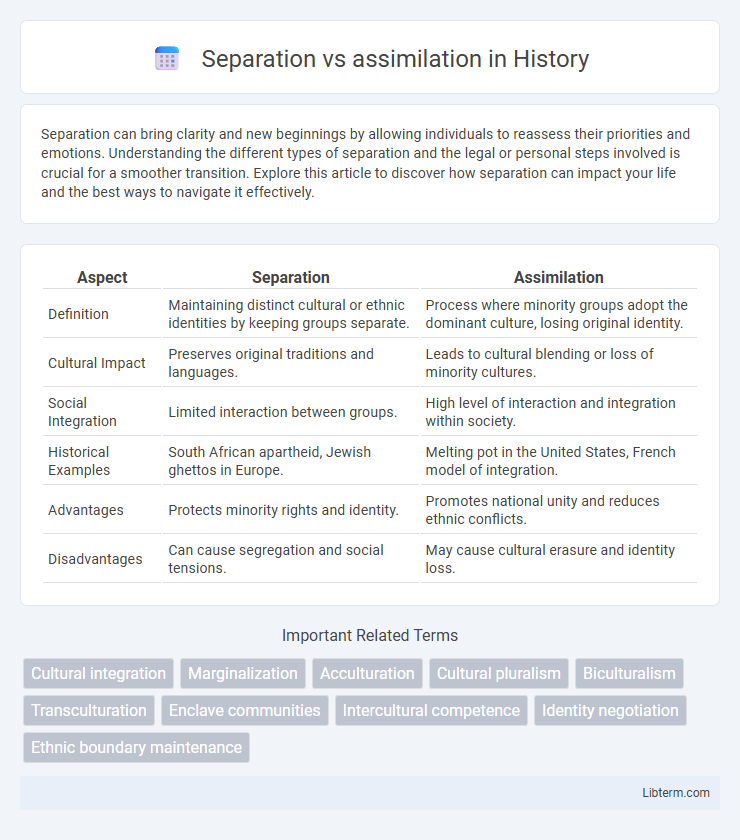Separation can bring clarity and new beginnings by allowing individuals to reassess their priorities and emotions. Understanding the different types of separation and the legal or personal steps involved is crucial for a smoother transition. Explore this article to discover how separation can impact your life and the best ways to navigate it effectively.
Table of Comparison
| Aspect | Separation | Assimilation |
|---|---|---|
| Definition | Maintaining distinct cultural or ethnic identities by keeping groups separate. | Process where minority groups adopt the dominant culture, losing original identity. |
| Cultural Impact | Preserves original traditions and languages. | Leads to cultural blending or loss of minority cultures. |
| Social Integration | Limited interaction between groups. | High level of interaction and integration within society. |
| Historical Examples | South African apartheid, Jewish ghettos in Europe. | Melting pot in the United States, French model of integration. |
| Advantages | Protects minority rights and identity. | Promotes national unity and reduces ethnic conflicts. |
| Disadvantages | Can cause segregation and social tensions. | May cause cultural erasure and identity loss. |
Introduction to Separation and Assimilation
Separation and assimilation represent two contrasting sociocultural strategies for managing differences within diverse societies. Separation emphasizes maintaining distinct cultural identities and practices without integrating into the dominant culture, often to preserve heritage and resist assimilation pressures. Assimilation involves individuals or groups adopting the dominant culture's norms, values, and behaviors, leading to reduced cultural distinctiveness over time.
Defining Separation and Assimilation
Separation refers to the process where a group maintains its distinct cultural identity while limiting interaction with the dominant society. Assimilation involves the absorption of minority groups into the dominant culture, leading to a loss of original cultural traits. Both concepts highlight different strategies for cultural integration and social cohesion in multicultural settings.
Historical Context of Both Concepts
Separation and assimilation have been central themes in the historical discourse on cultural integration, particularly during periods of colonialism and immigration. Separation refers to the policy or practice of maintaining distinct cultural identities and social boundaries, often enforced to preserve power structures or prevent cultural erosion. Assimilation, by contrast, involves the absorption of minority groups into the dominant culture, frequently promoted through state policies aiming at social cohesion and uniformity, as seen in the treatment of Native American tribes in the 19th century and immigrant groups in early 20th-century America.
Key Differences Between Separation and Assimilation
Separation emphasizes maintaining distinct cultural identities by preserving traditional customs, languages, and practices within a community, whereas assimilation involves adopting the dominant culture's norms, often leading to the loss of original cultural traits. Separation fosters cultural diversity and group cohesion but may limit social integration, while assimilation promotes societal unity at the potential cost of cultural homogenization. Key differences include the degree of cultural retention, levels of social interaction with the dominant group, and the impact on identity formation.
Social Impact on Minority and Majority Groups
Separation often leads to social fragmentation, limiting minority groups' access to resources and opportunities, while reinforcing majority groups' dominance and social cohesion. Assimilation promotes social integration by encouraging minority groups to adopt the majority culture, potentially reducing overt discrimination but risking loss of cultural identity. Both dynamics significantly shape social interactions, power structures, and access to socioeconomic benefits within diverse societies.
Psychological Effects of Each Approach
Separation often leads to feelings of isolation, reduced social integration, and increased identity stress, impacting mental well-being negatively. Assimilation can promote social cohesion and acceptance but may cause loss of cultural identity and internal conflict, affecting self-esteem and psychological resilience. Both approaches influence cognitive adaptation processes and emotional health differently, highlighting the importance of balanced cultural integration strategies for positive mental outcomes.
Case Studies: Separation vs Assimilation in Practice
Case studies illustrate that separation often preserves cultural identity by maintaining distinct social boundaries, such as in the Amish communities in the United States, while assimilation tends to promote social cohesion and economic integration exemplified by immigrant communities in urban centers like New York City. Research on the Chinese Diaspora in Southeast Asia reveals varying outcomes where assimilation into the dominant culture leads to increased opportunities but potential loss of original heritage, contrasting with separation in Chinatowns that sustain traditional customs and social networks. Analysis of these case studies underscores the complex trade-offs between cultural preservation and socioeconomic integration, influencing policy decisions on multiculturalism and immigrant inclusion.
Political and Legal Implications
Separation policies often lead to the establishment of distinct political entities or legal frameworks that reinforce group identities, potentially resulting in unequal rights or territorial disputes. Assimilation promotes uniform legal systems and political integration, which can enhance national unity but sometimes at the expense of minority group autonomy and cultural recognition. Both approaches pose significant challenges for policymakers balancing the enforcement of inclusive laws with respect for diversity and self-determination.
Cultural Preservation vs Cultural Integration
Separation emphasizes cultural preservation by encouraging distinct cultural identities and practices within a society, enabling minority groups to maintain language, traditions, and customs without pressure to conform. Assimilation promotes cultural integration, where individuals adopt the dominant culture's values, norms, and behaviors, facilitating social cohesion but potentially leading to the erosion of unique cultural heritages. Balancing cultural preservation and integration is critical for fostering inclusive communities that respect diversity while promoting shared social unity.
Finding Balance: Towards Inclusive Societies
Finding balance between separation and assimilation is crucial for building inclusive societies that respect cultural diversity while fostering social cohesion. Policies promoting intercultural dialogue and shared public spaces encourage mutual understanding without erasing individual identities. Effective integration frameworks emphasize participation, equality, and recognition of minority rights to create harmonious multicultural environments.
Separation Infographic

 libterm.com
libterm.com